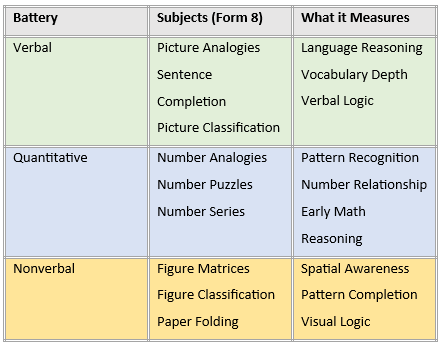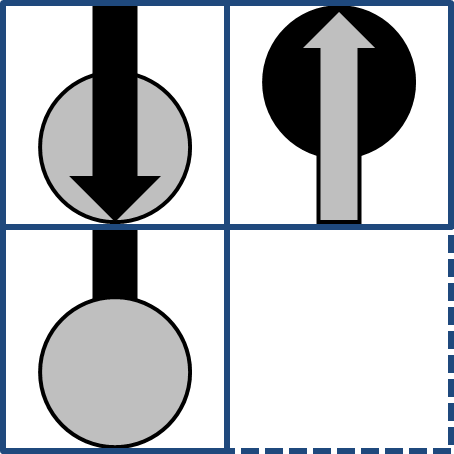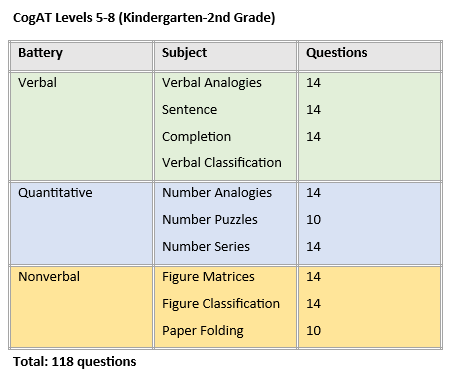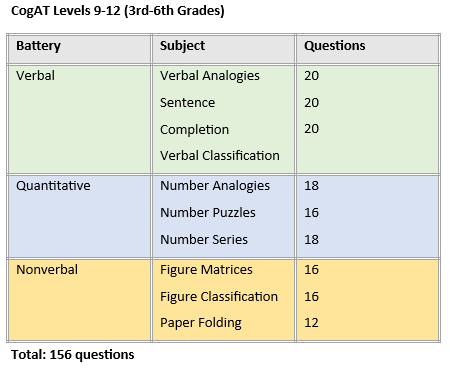The CogAT Test (Cognitive Abilities Test) is a widely used assessment that measures how students reason through verbal, quantitative, and nonverbal tasks. These reasoning skills give educators insight into a child’s learning potential. Schools administer the CogAT from early childhood through high school, with gifted programs commonly using it in elementary grades.
I’m Roni, a TestPrep-Online specialist in cognitive assessments. In this 2025–2026 Form 8 parent guide, I'll guide you through everything you need to know about the CogAT:
- What the CogAT measures and what’s included in Form 8
- How each battery works, with sample questions
- Which CogAT Level your child will take
- How schools use the CogAT for gifted identification
- How CogAT scores work and what they mean for your child
- How to prepare for the CogAT
- Frequently asked questions from parents
What Exactly Is on the 2025 CogAT Test?
The CogAT is not an IQ test. It measures how students reason and make connections, rather than what they have memorized. These reasoning skills can be strengthened through structured practice, especially when students are familiar with CogAT-style questions.
The 2025–2026 CogAT Test (Form 8) measures how well children reason using three kinds of thinking:
- Verbal reasoning
- Quantitative reasoning
- Nonverbal reasoning
Each of these is called a battery, and each battery contains 3 subtests, making 9 subtests total.

CogAT Batteries and Subtests by Category
Verbal Battery
The Verbal Battery evaluates how students understand and work with language. At early levels, questions use pictures and spoken instructions to assess how children connect ideas, apply logic, and recognize relationships between words and images.
At higher levels, the battery shifts to written language and examines how students interpret meanings, identify relationships between words, and apply verbal reasoning skills.
Picture or Verbal Analogies
What Students See
Pairs of pictures (younger students) or pairs of words (older students) that show a relationship.
What They Do
Identify the relationship and choose the picture or word that completes a second, matching pair.
Sentence Completion
What Students See
A spoken sentence with picture choices (younger students) or a written sentence with multiple-choice words (older students).
What They Do
Select the picture or word that best completes the sentence.
Picture or Verbal Classification
What Students See
A set of three pictures for younger students or three words for students in 3rd grade and above.
What They Do
Determine how the items are alike and select the picture or word that belongs in the group
Quantitative Battery
The Quantitative Battery assesses how students understand and work with number relationships. At early levels, questions use visual representations such as beads, dots, and object groups to help children recognize quantities and identify patterns without requiring formal math symbols.
As students progress to higher levels, the battery shifts from picture-based items to numerical ones. Students demonstrate how they reason about quantity, detect number patterns, and solve basic mathematical relationships.
Number Analogies
What Students See
A 2 × 2 matrix showing number relationships using pictures (younger students) finding the relationship between a pair of numbers (older students)
What They Do
Identify the numerical rule and choose the picture or number that completes the matrix.
Number Puzzles
What Students See
Visual representations of quantities, such as trains, beads, or dots (younger students), or equations with missing values (older students).
What They Do
Match quantities or solve the equation by selecting the correct missing number.
Number Series
What Students See
Rows of objects or beads showing a quantity pattern (younger students), or a sequence of numbers (older students).
What They Do
Identify the pattern and select the item or number that comes next
Nonverbal Battery
The Nonverbal Battery assesses reasoning without relying on language. Children solve picture- and shape-based puzzles that evaluate spatial awareness, pattern recognition, and logical thinking. This battery is especially useful for students who are still developing English proficiency.
At higher levels, the questions involve more complex visual reasoning. Students analyze abstract designs, identify transformation rules, and apply logical strategies to complete visual patterns.
Figure Matrices
What Students See
A 2 × 2 grid of shapes with one missing cell, from simple pictures to complex ones.
What They Do
Determine the visual rule and select the shape that completes the pattern.
Paper Folding
What Students See
Images of paper being folded and punched, sometimes with multiple folds.
What They Do
Visualize the unfolding process and select how the paper will look when opened.
Figure Classification
What Students See
Groups of shapes that range from simple figures to complex abstract designs.
What They Do
Identify shared visual features and select the figure that belongs with the group.
Video Introduction To the CogAT Test
Explore our in-depth CogAT test prep course designed to boost your child's performance.
CogAT Test Sample Questions
Each CogAT grade level is divided into batteries. This page presents one sample question per grade. To explore additional questions by grade and battery, visit our CogAT Sample Questions page.
CogAT Kindergarten - Picture Classification

Which picture from the answer choices belongs with the others?
CogAT 1st Grade - Figure Classification

Which shape from the answer choices belongs with the ones above?
CogAT 2nd Grade - Paper Folding
This piece of paper is being folded and then punched with holes.

Choose the answer choice that depicts the paper after it is unfolded.
CogAT 3rd Grade - Verbal Analogies
The first pair of words are related in a certain way.
peach → fruit : lily →
Choose the word that completes a second pair of words so that they are related in the same way.
CogAT 4th Grade - Figure Matrices
The pictures in the boxes on the top are connected in a certain way.

Choose the picture that belongs with the bottom picture in the same way the pictures on top are connected.
CogAT 5th - Number Series
What number comes next in the series?
50, 54, 41, 45, 32, ?
CogAT 6th Grade - Number Puzzles
Look at the number sentences below.
? - 21 = ◊ ÷ 7
◊ + 3 = 45
Choose the answer that makes both number sentences true.
Can You Prepare for the CogAT?
Preparation focuses on helping students understand what CogAT questions look like and how to work through them under timed conditions. When the format feels familiar, students are better able to focus on reasoning and problem-solving rather than adjusting to unfamiliar task types.
Three facts every parent should know:
- The CogAT Test is highly coachable.
- The reason isn't memorization. It's familiarity with how to think through analogy, classification, and pattern tasks.
- Students from "test-ready" households tend to score higher.
Not because they are more gifted. But because they have richer language exposure, more puzzle/problem-solving conversations, more experience with visual reasoning tasks and have had structured practice levels the field.
How is the CogAT Test Scored?
Understanding Your Child's CogAT Scores
The CogAT gives your child a score profile that shows their thinking strengths across the three batteries: Verbal, Quantitative, and Nonverbal.
Each profile includes:
- A stanine number (1-9 scale) showing overall ability level
- A letter code (A-D) showing how balanced the scores are
- Plus or minus signs (like V+, Q+, or N−) highlighting specific strengths or growth areas
Scores are age-normed, which means your child is compared to other students nationwide who are the same age, not to their classmates or grade-level peers. This is very important for accurate assessment.
For example, V+ means verbal strength (great at reading and language), while Q+ indicates quantitative strength (strong problem-solver with numbers).
Most gifted programs require a composite or battery score in the 92nd–97th percentile, while highly selective districts often require 98th or 99th percentile.
Want the full details? Click here for our complete CogAT scoring guide to learn about percentiles, age scores, and how to read your child's report.
Which CogAT Level Will My Child Take? (Grade-by-Grade Chart)
The CogAT can feel confusing because it is organized by age levels rather than grade numbers. Each test level matches the typical age of students in a grade, not the grade itself. For example, kindergarten students (ages 5–6) usually take Level 5/6, first graders (ages 6–7) take Level 7, second graders (ages 7–8) take Level 8, and this pattern continues up through sixth grade, where students ages 11–12 take Level 12. Schools choose the CogAT level based on a child’s age at the time of testing, which is why two students in the same grade may sometimes take different levels.
How Many Questions Are on Each Level of the CogAT?
Each CogAT level contains 9 subtests. The number of questions varies by age.
Here's the full breakdown:


What Is the Latest Version of the CogAT? (Form 8 Explained)
Most districts use both CogAT Form 7 and Form 8. They're interchangeable parallel forms measuring the same abilities with equivalent structure and comparable scores.
Form 8 is newer and increasingly preferred. It introduces completely new questions with no overlap, allowing schools to retest students without repeated content. It also uses updated norms from a larger, more diverse sample and emphasizes problem-solving and critical-thinking skills.
You'll see both forms in active use depending on your district's testing contract.
How Is the CogAT Administered in 2025–2026?
Most students now take CogAT Form 8 digitally, though some districts still offer paper versions for younger grades. The test is given in either fall or spring, depending on the district. It's a multiple-choice format that takes about 90–120 minutes total to complete.
Schools use CogAT results for gifted placement, to understand student learning profiles, and for instructional planning.
|
Format |
Details |
|
Online (most common) |
Students use a school laptop or Chromebook. Adaptive timing. Auto-scored. |
|
Paper (some Kindergarten–2 classes) |
The teacher reads instructions aloud. Students fill in bubbles. |
|
Group testing |
Usually 10–30 students at once in a classroom. |
|
Individual testing |
Rare, for special needs, makeup exams, or placement reviews. |
Ask Roni

An educational technology expert with a background in Physics and Astronomy and over nine years of experience designing AI-enhanced assessment materials that mirror real digital testing environments. Roni creates prep packs with clear, thoughtfully structured practice that strengthen understanding, build confidence with edtech tools, and empower every learner to succeed in an evolving digital landscape.
Cognitive Abilities Test CogAT FAQ's
The CogAT Form 8 is the most current version of the Cognitive Abilities Test used by schools today. It measures a student’s reasoning abilities across three areas: Verbal, Quantitative, and Nonverbal reasoning. While the core skills assessed remain consistent with earlier versions, Form 8 reflects updated question design, clearer visuals, and improved statistical norms. Schools adopted Form 8 to better align the test with modern classroom expectations and to ensure more accurate comparisons across age groups.
The difference between CogAT Form 7 and Form 8 is structural rather than conceptual. Both forms assess the same reasoning skills and use the same three batteries. However, Form 8 includes refined question formats, updated artwork, and revised norms based on more recent student data. Importantly, scores from Form 7 and Form 8 are interpreted the same way, meaning a strong score on either form carries equal weight for gifted and talented placement.
Each subtest takes 8–12 minutes, and the full test lasts:
- K–2: about 75–90 minutes
- 3rd–6th: 90–120 minutes
Yes. Younger students take the test with headphones because many questions are read aloud.
Teachers can:
- read directions
- give examples
- assist with technical issues
They cannot:
- explain how to solve questions
- help with unclear items
- give extra time
This is why familiarity with the test format is extremely important for young children.
Schools rely on the CogAT Test because it offers a clear picture of how students think, especially students who:
- don't perform well on achievement tests
- are multilingual learners
- haven't had access to enrichment
- show signs of high potential but inconsistent grades
Many districts now administer the CogAT to all students in certain grades (often 1st or 2nd).
This matters because:
- It reduces bias
- It identifies students who might otherwise go unnoticed
- It supports equity in gifted identification
Example: Fairfax County Public Schools (VA) screens nearly every student in Grade 2 with the CogAT Form 8.
CogAT scores compare your child to age-level peers nationwide, not to their classmates.
This is helpful because:
- a very advanced class won't "hide" a gifted child
- a struggling class won't inflate scores
- age norms prevent younger-for-grade students from being disadvantaged
Yes. One of the most powerful uses of the CogAT Test is discovering potential in students who may not show it on typical achievement tests.
Many districts report that 20–30% of newly identified gifted students were previously "unknown candidates."
These often include:
- shy students
- English language learners
- high-ability students with ADHD
- students from underrepresented groups
- The Nonverbal Battery is particularly helpful here.
The Verbal Battery shifts from picture-based questions to word-based analogies and written sentences, so students need to read and reason with text instead of just listening and looking at images.
The Quantitative Battery moves from counting beads and dots to working with actual numbers and symbols, requiring students to solve equations and recognize numeric patterns.
The Nonverbal Battery stays visual but becomes much more complex, with abstract shapes that follow multiple rules at once instead of simple pattern matching.


